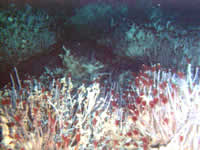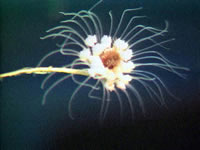| |
| |

A field of tubeworms was encountered at
BagCity vent, many covered with limpets. The 1998 eruption reinvigorated
this area. The tubeworms certainly seem to like it.)

A Cnidarian, likely a stalked jellyfish,
was attached to the marker at the
caldera
center (1536 meters) when we arrived to do a pressure measurement.
. |
|
NOAA Ship Ron Brown/ROV ROPOS
Science News
Science Report - Saturday, July 21, 2001
Ship's position: 45 56.0'/-130 00.8'
ROPOS
is on its way down to the seafloor for its first visit of this year to
the ASHES hydrothermal
field, where sulfide chimneys up to 5 m high vent high-temperature
fluid (over 300 degrees C). ASHES is located in the southwest corner of
Axial caldera near the caldera wall, about a mile west of the 1998 lava
flow. During this dive (R624), ROPOS will be collecting a suite of vent
fluid samples from low- and high-temperature vents, deploying and recovering
temperature probes, taking suction samples of sediment and fauna, making
video observations of sulfide worm behavior, as well as deploying larval
traps and settling arrays. ASHES has been active since discovered in 1984,
but temperature and chemical changes were observed before and after the
1998 eruption indicating that it is intimately connected to the Axial
magmatic system. ASHES is also interesting because it is one of the few
sites where the hydrothermal vent fluid is hot enough to boil and separate
into two phases, a vapor phase and a brine phase, that come out of the
seafloor in different parts of the vent field.
|
|

